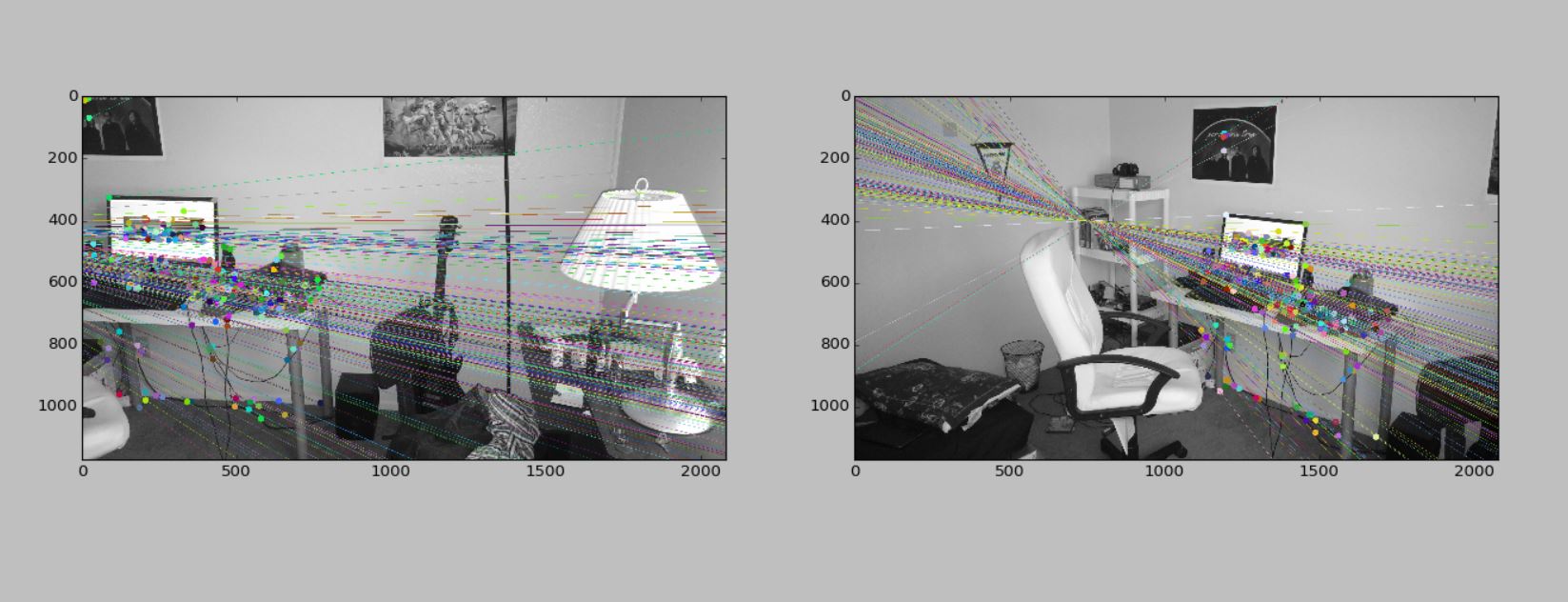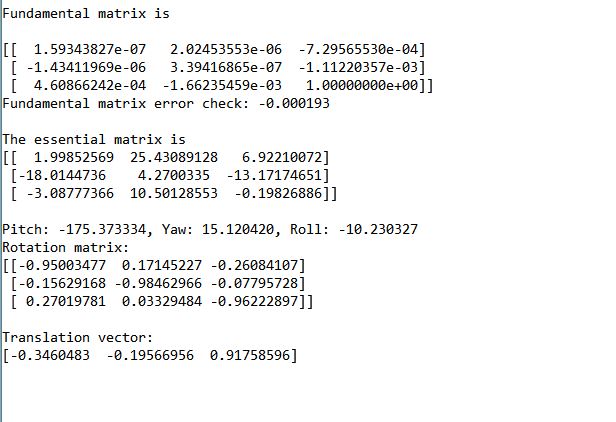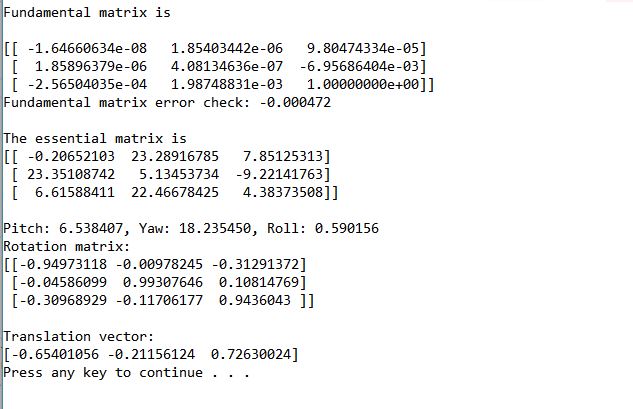我正在尝试使用 OpenCV 来估计相机相对于另一个的一个姿势,使用 SIFT 特征跟踪、FLANN 匹配以及基本矩阵和基本矩阵的后续计算。分解基本矩阵后,我检查退化配置并获得“正确的”R 和 t。
问题是,他们似乎从来都不是对的。我包括几个图像对:
- 图像 2 沿 Y 轴旋转 45 度且位置与 w.r.t. 相同。图 1。
结果
- 图片 2 取自大约。沿负 X 方向几米远,负 Y 方向轻微位移。约相机姿势沿 Y 轴旋转 45-60 度。
结果
第二种情况下的平移向量似乎高估了 Y 方向的运动而低估了 X 方向的运动。在这两种情况下,转换为欧拉角的旋转矩阵都会给出错误的结果。许多其他数据集也会发生这种情况。我已经尝试在 RANSAC、LMEDS 等之间切换基本矩阵计算技术,现在我正在使用 RANSAC 进行计算,第二次计算仅使用 8 点法的内点。更改特征检测方法也无济于事。对极线似乎是适当的,基本矩阵满足x'.F.x = 0
我是否遗漏了一些根本性的错误?如果程序正确理解对极几何,可能会发生什么导致完全错误的姿势?我正在检查以确保点位于两个摄像头前面。任何想法/建议都会非常有帮助。谢谢!
编辑:尝试使用相同的技术,将两个不同的校准相机隔开;并计算基本矩阵为 K2'.F.K1,但平移和旋转仍然有很大差距。
Code供引用
import cv2
import numpy as np
from matplotlib import pyplot as plt
# K2 = np.float32([[1357.3, 0, 441.413], [0, 1355.9, 259.393], [0, 0, 1]]).reshape(3,3)
# K1 = np.float32([[1345.8, 0, 394.9141], [0, 1342.9, 291.6181], [0, 0, 1]]).reshape(3,3)
# K1_inv = np.linalg.inv(K1)
# K2_inv = np.linalg.inv(K2)
K = np.float32([3541.5, 0, 2088.8, 0, 3546.9, 1161.4, 0, 0, 1]).reshape(3,3)
K_inv = np.linalg.inv(K)
def in_front_of_both_cameras(first_points, second_points, rot, trans):
# check if the point correspondences are in front of both images
rot_inv = rot
for first, second in zip(first_points, second_points):
first_z = np.dot(rot[0, :] - second[0]*rot[2, :], trans) / np.dot(rot[0, :] - second[0]*rot[2, :], second)
first_3d_point = np.array([first[0] * first_z, second[0] * first_z, first_z])
second_3d_point = np.dot(rot.T, first_3d_point) - np.dot(rot.T, trans)
if first_3d_point[2] < 0 or second_3d_point[2] < 0:
return False
return True
def drawlines(img1,img2,lines,pts1,pts2):
''' img1 - image on which we draw the epilines for the points in img1
lines - corresponding epilines '''
pts1 = np.int32(pts1)
pts2 = np.int32(pts2)
r,c = img1.shape
img1 = cv2.cvtColor(img1,cv2.COLOR_GRAY2BGR)
img2 = cv2.cvtColor(img2,cv2.COLOR_GRAY2BGR)
for r,pt1,pt2 in zip(lines,pts1,pts2):
color = tuple(np.random.randint(0,255,3).tolist())
x0,y0 = map(int, [0, -r[2]/r[1] ])
x1,y1 = map(int, [c, -(r[2]+r[0]*c)/r[1] ])
cv2.line(img1, (x0,y0), (x1,y1), color,1)
cv2.circle(img1,tuple(pt1), 10, color, -1)
cv2.circle(img2,tuple(pt2), 10,color,-1)
return img1,img2
img1 = cv2.imread('C:\\Users\\Sai\\Desktop\\room1.jpg', 0)
img2 = cv2.imread('C:\\Users\\Sai\\Desktop\\room0.jpg', 0)
img1 = cv2.resize(img1, (0,0), fx=0.5, fy=0.5)
img2 = cv2.resize(img2, (0,0), fx=0.5, fy=0.5)
sift = cv2.SIFT()
# find the keypoints and descriptors with SIFT
kp1, des1 = sift.detectAndCompute(img1,None)
kp2, des2 = sift.detectAndCompute(img2,None)
# FLANN parameters
FLANN_INDEX_KDTREE = 0
index_params = dict(algorithm = FLANN_INDEX_KDTREE, trees = 5)
search_params = dict(checks=50) # or pass empty dictionary
flann = cv2.FlannBasedMatcher(index_params,search_params)
matches = flann.knnMatch(des1,des2,k=2)
good = []
pts1 = []
pts2 = []
# ratio test as per Lowe's paper
for i,(m,n) in enumerate(matches):
if m.distance < 0.7*n.distance:
good.append(m)
pts2.append(kp2[m.trainIdx].pt)
pts1.append(kp1[m.queryIdx].pt)
pts2 = np.float32(pts2)
pts1 = np.float32(pts1)
F, mask = cv2.findFundamentalMat(pts1,pts2,cv2.FM_RANSAC)
# Selecting only the inliers
pts1 = pts1[mask.ravel()==1]
pts2 = pts2[mask.ravel()==1]
F, mask = cv2.findFundamentalMat(pts1,pts2,cv2.FM_8POINT)
print "Fundamental matrix is"
print
print F
pt1 = np.array([[pts1[0][0]], [pts1[0][1]], [1]])
pt2 = np.array([[pts2[0][0], pts2[0][1], 1]])
print "Fundamental matrix error check: %f"%np.dot(np.dot(pt2,F),pt1)
print " "
# drawing lines on left image
lines1 = cv2.computeCorrespondEpilines(pts2.reshape(-1,1,2), 2,F)
lines1 = lines1.reshape(-1,3)
img5,img6 = drawlines(img1,img2,lines1,pts1,pts2)
# drawing lines on right image
lines2 = cv2.computeCorrespondEpilines(pts1.reshape(-1,1,2), 1,F)
lines2 = lines2.reshape(-1,3)
img3,img4 = drawlines(img2,img1,lines2,pts2,pts1)
E = K.T.dot(F).dot(K)
print "The essential matrix is"
print E
print
U, S, Vt = np.linalg.svd(E)
W = np.array([0.0, -1.0, 0.0, 1.0, 0.0, 0.0, 0.0, 0.0, 1.0]).reshape(3, 3)
first_inliers = []
second_inliers = []
for i in range(len(pts1)):
# normalize and homogenize the image coordinates
first_inliers.append(K_inv.dot([pts1[i][0], pts1[i][1], 1.0]))
second_inliers.append(K_inv.dot([pts2[i][0], pts2[i][1], 1.0]))
# Determine the correct choice of second camera matrix
# only in one of the four configurations will all the points be in front of both cameras
# First choice: R = U * Wt * Vt, T = +u_3 (See Hartley Zisserman 9.19)
R = U.dot(W).dot(Vt)
T = U[:, 2]
if not in_front_of_both_cameras(first_inliers, second_inliers, R, T):
# Second choice: R = U * W * Vt, T = -u_3
T = - U[:, 2]
if not in_front_of_both_cameras(first_inliers, second_inliers, R, T):
# Third choice: R = U * Wt * Vt, T = u_3
R = U.dot(W.T).dot(Vt)
T = U[:, 2]
if not in_front_of_both_cameras(first_inliers, second_inliers, R, T):
# Fourth choice: R = U * Wt * Vt, T = -u_3
T = - U[:, 2]
# Computing Euler angles
thetaX = np.arctan2(R[1][2], R[2][2])
c2 = np.sqrt((R[0][0]*R[0][0] + R[0][1]*R[0][1]))
thetaY = np.arctan2(-R[0][2], c2)
s1 = np.sin(thetaX)
c1 = np.cos(thetaX)
thetaZ = np.arctan2((s1*R[2][0] - c1*R[1][0]), (c1*R[1][1] - s1*R[2][1]))
print "Pitch: %f, Yaw: %f, Roll: %f"%(thetaX*180/3.1415, thetaY*180/3.1415, thetaZ*180/3.1415)
print "Rotation matrix:"
print R
print
print "Translation vector:"
print T
plt.subplot(121),plt.imshow(img5)
plt.subplot(122),plt.imshow(img3)
plt.show()
最佳答案
有很多因素会导致根据点对应关系对相机位姿的估计不准确。您必须考虑的一些因素:-
(*) 8 点法最小化代数误差 ( x'.F.x = 0)。通常最好找到一个能最小化有意义的几何误差的解决方案。例如,您可以在 RANSAC 实现中使用重新投影误差。
(*) 从8点求解基本矩阵的线性算法对噪声敏感。亚像素级精确点匹配、适当的数据归一化和精确的相机校准对于获得更好的结果都很重要。
(*) 特征点定位和匹配导致噪声点匹配,因此通过求解代数方程 x'Fx 得到的解应该真正用作初始估计,并且需要应用参数优化等进一步步骤优化解决方案。
(*) 一些双 View 相机配置可能会导致模糊的解决方案,因此需要进一步的方法(例如第三 View 消歧)以获得可靠的结果。
关于python - 对极几何姿态估计 : Epipolar lines look good but wrong pose,我们在Stack Overflow上找到一个类似的问题: https://stackoverflow.com/questions/31737688/



